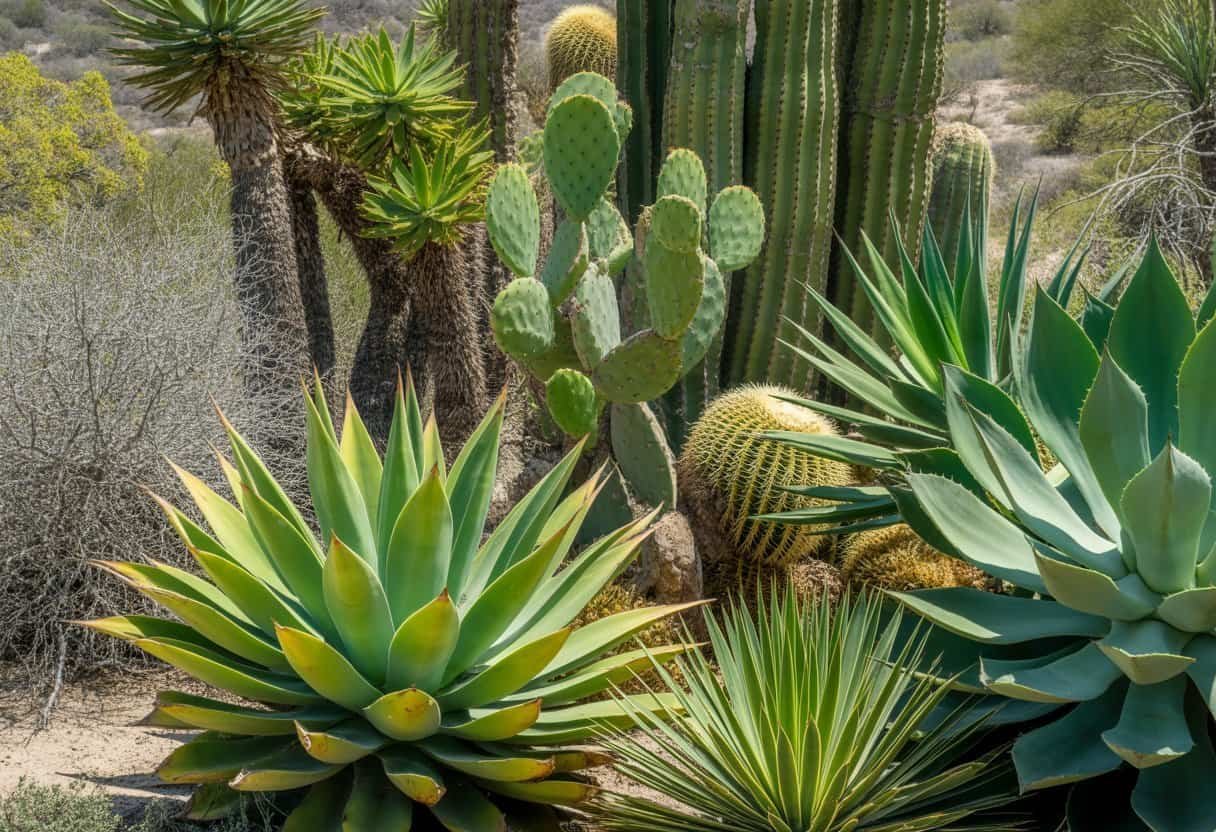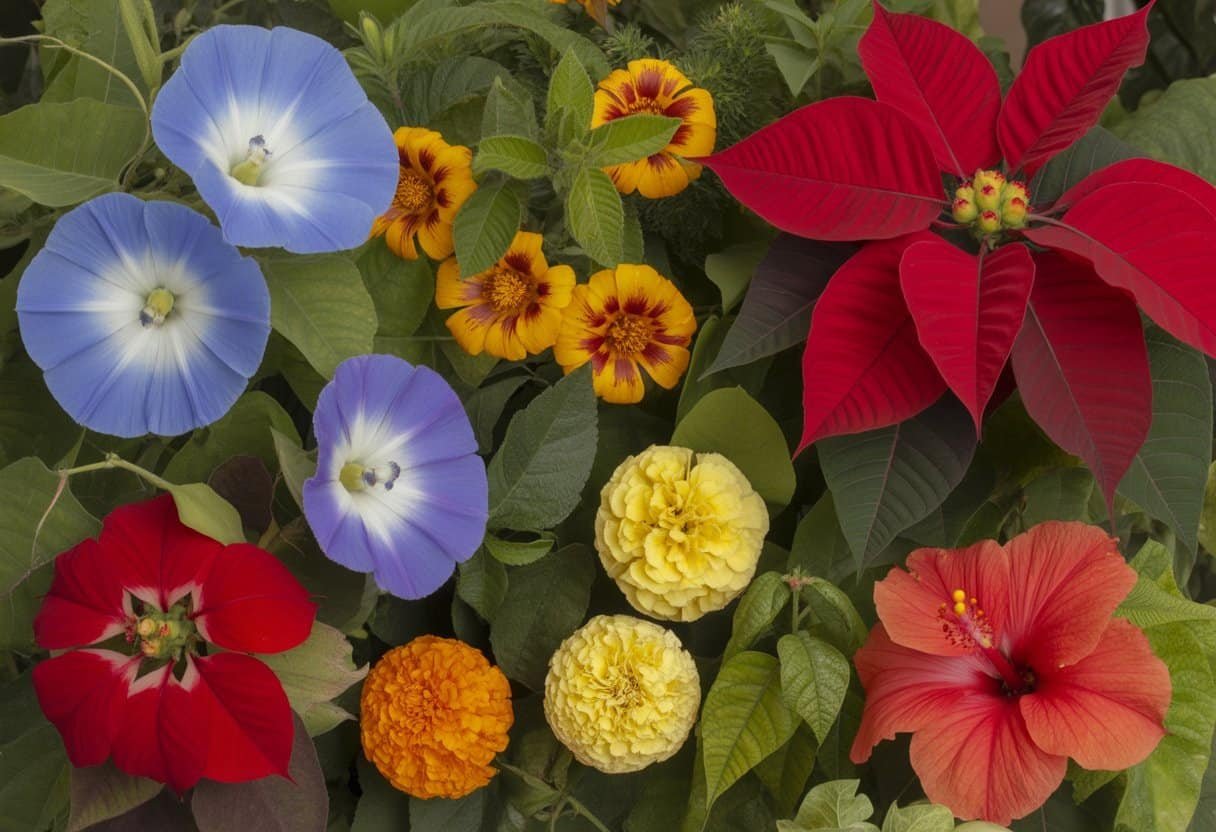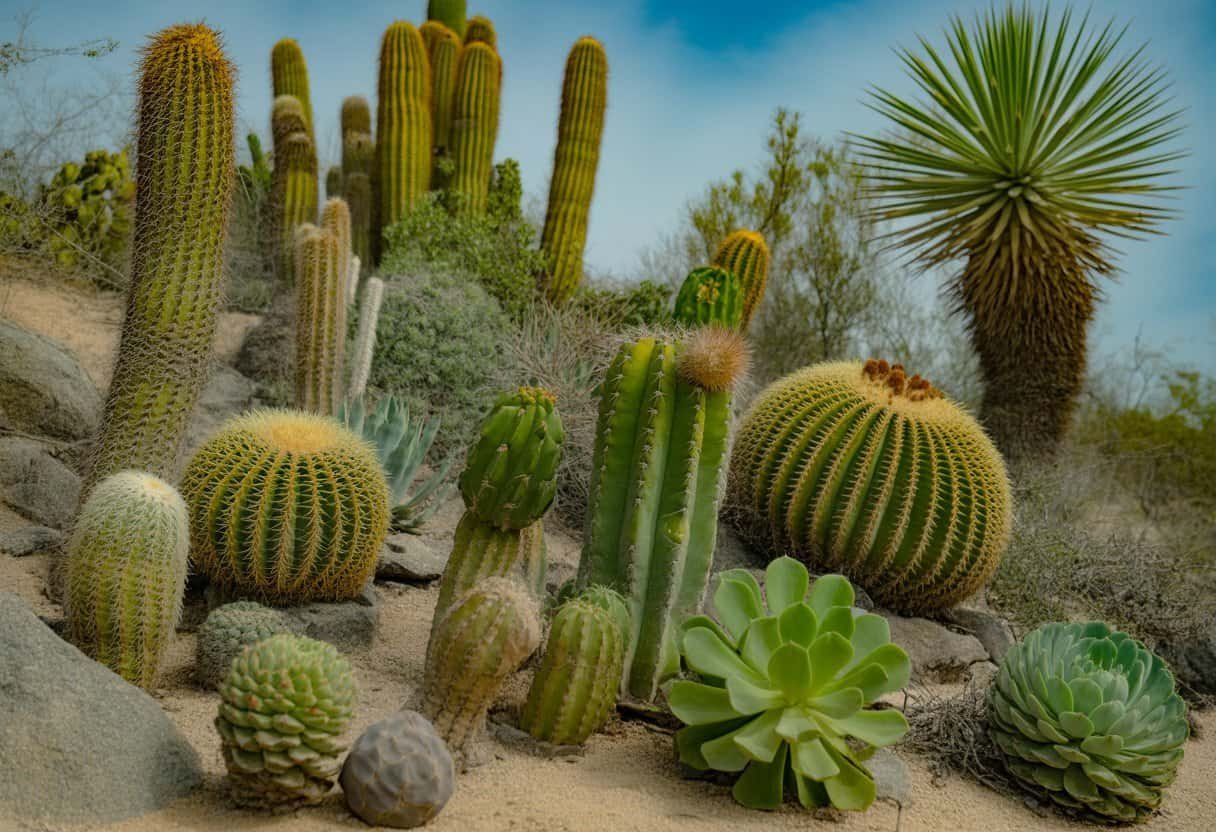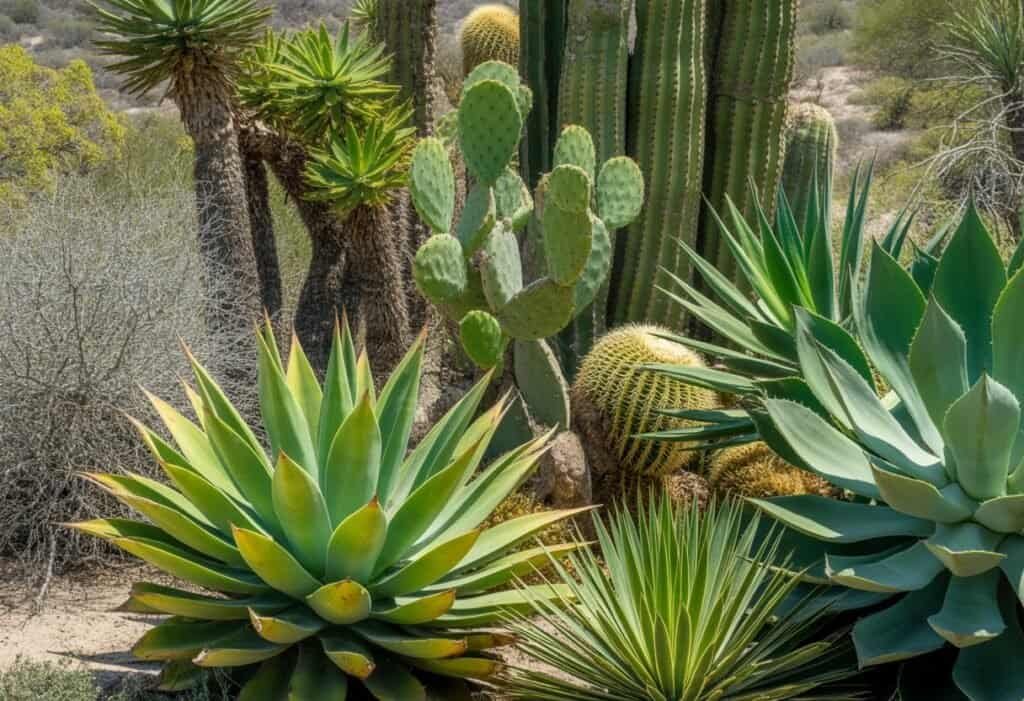Mexico is home to an incredible variety of plant life that thrives in its diverse ecosystems. From the arid deserts of the north to the tropical rainforests of the south, Mexican native plants display remarkable adaptations and beauty.
These native species have played crucial roles in Mexican culture for centuries.
They provide food, medicine, building materials, and inspiration for art and traditions.

The country boasts over 30,000 plant species, with roughly 15,000 being endemic.
Endemic means they grow nowhere else on Earth.
This botanical richness includes iconic plants like the blue agave, used to make tequila.
The dahlia, Mexico’s national flower, also stands out among native species.
Many Mexican native plants have become popular in gardens worldwide.
They are known for their resilience, striking forms, and vivid colors.
Key Takeaways
- Mexico’s diverse landscapes support over 30,000 plant species, with nearly half found nowhere else on Earth.
- Native Mexican plants like agave, dahlias, and various cacti have significant cultural and practical uses in food, medicine, and crafts.
- Many Mexican native plants thrive in drought conditions, making them excellent choices for water-wise gardening in similar climates.
Overview of Mexico’s Native Flora
Mexico’s plant diversity ranks among the highest in the world.
Over 26,000 native species grow across the country’s diverse ecosystems.
This botanical richness reflects Mexico’s varied topography, climate zones, and geological history.
Regions and Diversity
Mexico’s native flora varies dramatically across its ecological regions.
The northern deserts feature drought-resistant plants like agave, yucca, and many cacti species.
These plants have evolved specialized water storage tissues and protective mechanisms against heat.
The central highlands support pine-oak forests.
Evergreen shrubs and herbaceous perennials thrive in moderate conditions here.
Many plants in this region show adaptations to seasonal rainfall patterns.
Tropical regions in southern Mexico host incredible biodiversity.
Some areas contain over 700 tree species.
The Yucatán Peninsula features unique limestone-adapted vegetation.
Coastal areas support mangroves.
High-altitude zones contain specialized alpine species.
This regional diversity has made Mexico a global hotspot for plant endemism.
About 40% of plants grow only in Mexico.
Major Plant Families
Asteraceae (sunflower family) dominates Mexico’s flora with over 3,000 species.
Many of these herbaceous perennials have traditional medicinal uses.
Mexico serves as an important diversification center for this family.
Cactaceae (cactus family) shows remarkable diversity with nearly 850 species.
Mexico is the world center for cactus evolution.
These cacti range from tiny ground-hugging forms to massive columnar types.
Fabaceae (legume family) contributes significantly with trees like mesquite.
Colorful flowering plants in this family enrich soils through nitrogen fixation.
Other prominent families include:
- Orchidaceae: 1,200+ species of orchids
- Poaceae: Native grasses adapting to various habitats
- Pinaceae: Pine species forming extensive forests
- Agavaceae: Includes economically important agaves used for fiber and beverages
Ecological Importance
Mexico’s native plants form the foundation for diverse ecosystems.
Thousands of animal species depend on them.
Many flowering plants have co-evolved with specific pollinators.
These relationships create intricate ecological connections.
Perennial plants and deciduous trees in Mexico’s forests regulate water cycles.
They help prevent soil erosion and sequester carbon.
The deep root systems of native vegetation maintain soil structure and fertility.
Native plants provide critical food sources and habitat for wildlife.
For example, monarch butterflies depend on native milkweed species during their migration.
Many Mexican ecosystems face threats from development, agriculture, and climate change.
Conservation efforts focus on protecting habitats with high concentrations of endemic species, especially in the Sierra Madre mountains and tropical forests of Chiapas.
Iconic Flowers Native to Mexico

Mexico’s diverse climate supports a stunning array of native flowers.
These flowers have become symbols of the country’s natural heritage and cultural traditions.
They play important roles in celebrations, medicine, and national identity.
Dahlia: National Flower of Mexico
The dahlia became Mexico’s national flower in 1963.
Native to Mexico’s highlands, these colorful blooms were cultivated by the Aztecs long before European contact.
Dahlias (Dahlia spp.) come in a remarkable variety of shapes, sizes, and colors.
Some varieties can grow up to dinner-plate size while others remain small and compact.
Their diversity includes 42 species and thousands of cultivars.
The Aztecs used dahlias for more than decoration.
They used the hollow stems as water pipes and ate the tubers as food.
Modern research shows dahlia tubers contain inulin, a dietary fiber beneficial for digestion.
Today, dahlias grace gardens worldwide.
Annual dahlia exhibitions in Mexico showcase the national flower’s beauty and cultural significance.
Mexican Marigold and Day of the Dead
The Mexican marigold (Tagetes erecta), known locally as cempasúchil or Aztec marigold, features prominently in Mexico’s Day of the Dead celebrations.
These bright orange and yellow flowers produce a scent believed to guide spirits back to earth.
Families create paths of marigold petals from cemeteries to home altars during the November festivities.
The tradition dates back to pre-Hispanic times when Aztecs used these flowers in rituals honoring the dead.
Mexican marigolds serve practical purposes beyond ceremonies.
Their strong scent repels garden pests, making them valuable companion plants.
The flowers also provide natural yellow dye for textiles and food.
Mexican marigolds grow easily in various conditions.
They thrive in Mexico’s diverse climates from coastal regions to highland areas.
Poinsettia: Euphorbia pulcherrima
Poinsettias, scientifically named Euphorbia pulcherrima, originate from Mexico.
The Aztecs called this plant cuetlaxochitl and valued it for both decorative and medicinal purposes.
The plant’s vibrant red “flowers” are actually modified leaves called bracts.
The true flowers are the small yellow structures at the center.
In the wild, poinsettias grow as shrubs reaching up to 10 feet tall.
Joel Roberts Poinsett, the first U.S. ambassador to Mexico, introduced the plant to the United States in 1825.
Today, poinsettias rank among the best-selling potted plants worldwide, especially during December holidays.
In their native Mexican habitat, poinsettias bloom naturally during winter.
Local legends connect the plant to Christmas, making it a traditional holiday decoration throughout Mexico and beyond.
Cacti and Succulent Species

Mexico hosts an incredible diversity of cacti and succulents.
These plants have adapted to survive in arid conditions with specialized water storage and protective features.
Prickly Pear and Maguey
The prickly pear cactus (Opuntia) stands as one of Mexico’s most iconic native plants.
Its flat, paddle-shaped segments are covered with clusters of spines and produce sweet edible fruits called tunas.
These cacti grow throughout Mexico.
People have used them for centuries as food, medicine, and natural fencing.
Maguey, also known as century plant, thrives in Mexico’s dry regions.
This large succulent features thick, fleshy leaves with spiny margins arranged in a rosette pattern.
Indigenous peoples have traditionally used maguey fibers for textiles and rope.
The silken pincushion cactus (Mammillaria bombycina) is a smaller but equally fascinating Mexican native.
This round cactus is covered with distinctive white, hair-like spines that protect it from predators and harsh sunlight.
Agave Varieties
Agave plants are quintessentially Mexican succulents with great cultural importance.
The blue agave (Agave tequilana) grows mainly in Jalisco state and serves as the essential ingredient for authentic tequila.
Agaves feature thick, spiky leaves arranged in rosettes that store water efficiently.
Most species take 8-30 years to mature before flowering once with a dramatic tall stalk.
Indigenous peoples harvested aguamiel (the sweet sap) to produce pulque, a traditional fermented beverage.
Today, various agave species remain important for producing mezcal, tequila, and natural sweeteners.
Yucca Species
Yucca plants thrive in Mexico’s arid landscapes with their sword-shaped leaves and impressive flowering stalks.
The banana yucca (Yucca baccata) produces edible, banana-shaped fruits that indigenous communities have harvested for generations.
Yucca thompsoniana, native to northern Mexico, features bluish-green leaves and beautiful white flower clusters.
These drought-resistant plants develop deep root systems to access underground water.
Many yucca species have a unique ecological relationship with yucca moths, their exclusive pollinators.
The moths deliberately collect and transfer pollen between yucca flowers, ensuring seed production for both species.
Mexican communities have traditionally used yucca fibers for making baskets, sandals, and rope.
The roots contain saponins that people use as natural soap and shampoo.
Notable Trees of Mexico
Mexico’s diverse landscapes support magnificent native trees that contribute to the country’s rich biodiversity.
These trees play vital roles in ecosystems and enhance urban areas with their distinctive beauty.
Mexican Sycamore
The Mexican Sycamore (Platanus mexicana) stands as one of Mexico’s most impressive native trees.
This deciduous tree can reach heights of 40-50 feet with a broad, spreading canopy that provides excellent shade.
Mexican Sycamores are easy to identify by their mottled bark that peels to reveal lighter patches underneath.
The bark creates a camouflage-like pattern of gray, white, and tan colors.
The large, maple-like leaves have 3-5 lobes and can span 5-8 inches across.
During fall, the foliage turns gold and amber before dropping.
These trees thrive along riverbanks and in moist canyons throughout northeastern and central Mexico.
Once established, they show remarkable drought tolerance and have become popular in sustainable landscaping projects.
Jacaranda
Jacaranda trees transform Mexican cities with their spectacular purple blooms each spring.
Though originally from South America, these trees have become iconic fixtures in many Mexican urban landscapes, especially in Mexico City and Oaxaca.
The Jacaranda mimosifolia displays delicate, fern-like foliage year-round in most Mexican regions.
Its most striking feature is the lavish display of trumpet-shaped purple-blue flowers that blanket the tree from February through May.
Many Mexican streets and plazas feature jacarandas planted during urban planning in the early 20th century.
These trees create stunning purple canopies that have become cultural symbols in art and literature.
Jacarandas prefer full sun and moderate water.
They thrive in Mexico’s central regions where they face minimal frost risk.
Their shallow roots make them suitable for urban settings.
Palms and Other Important Species
Palm trees define many Mexican landscapes, from coastal areas to desert oases.
The Mexican Fan Palm (Washingtonia robusta) rises up to 100 feet tall and decorates many streets and plazas.
The Mexican Royal Palm (Attalea cohune) grows naturally in the tropical southern regions.
Its massive fronds can reach 30 feet in length, making it one of the most impressive native palms.
The Montezuma Cypress (Taxodium mucronatum), also called “ahuehuete,” was sacred to the Aztecs and is now Mexico’s national tree.
The famous Árbol del Tule near Oaxaca is a Montezuma Cypress with the world’s widest tree trunk.
The Gumbo-limbo tree (Bursera simaruba) stands out for its reddish, peeling bark.
Native to southern Mexico, it’s sometimes called the “tourist tree” because its red, peeling skin resembles sunburned visitors.
Unique and Endemic Mexican Plants
Mexico’s diverse ecosystems support many plant species found nowhere else on Earth. These endemic plants have adapted to specific environmental conditions across Mexico’s varied landscapes.
Mexican Zinnia and Related Species
Mexican zinnia (Zinnia haageana) grows naturally in central Mexico’s highlands. This colorful wildflower reaches 12-18 inches tall with orange, red, or yellow blooms that attract butterflies and hummingbirds.
Unlike common garden zinnias, Z. haageana has smaller flowers with dark bands at the petal bases. These plants thrive in hot, dry conditions with minimal water.
Zinnia acerosa, called desert zinnia, is another Mexican native adapted to harsh environments. It grows as a low-spreading perennial with white ray flowers and yellow centers.
This drought-tolerant plant survives in rocky soils where few other flowering plants persist. Both species enrich Mexico’s botanical heritage and are popular in water-wise landscaping in the southwestern United States.
Chocolate Cosmos
Chocolate cosmos (Cosmos atrosanguineus) is a unique Mexican flower known for its chocolate scent. This perennial produces velvety, deep maroon-brown flowers that smell like chocolate or vanilla.
Wild chocolate cosmos is considered extinct in its natural habitat. Today, people grow it only through cultivation.
The plant grows from tuberous roots and can reach 2-3 feet tall. Gardeners value these plants for their unusual color and fragrance, especially in warm evening air.
Chocolate cosmos blooms from midsummer until the first frost. The flowers have eight petals arranged around a central dark eye.
These plants prefer full sun and well-drained soil with moderate moisture.
Mexican Poppy and Prickly Poppy
Mexican poppy (Argemone ochroleuca) thrives in disturbed areas throughout Mexico’s central regions. This annual plant grows 1-3 feet tall with blue-green foliage covered in sharp spines.
The flowers are bright white with golden yellow centers, opening wide in full sun. Each bloom measures 2-3 inches across with delicate, crepe-paper-like petals.
Mexican prickly poppy, a close relative, shows similar growth but adapts more easily to extreme conditions. Both species contain toxic alkaloids and have been used cautiously in traditional medicine.
These poppies spread quickly by dispersing seeds. After flowering, they produce spiny seed capsules that split open when mature.
Despite their spines, these poppies provide habitat for native pollinators throughout Mexico’s arid regions.
Orchids, Vines, and Flowering Climbers
Mexico’s climate creates perfect conditions for unique flowering plants that climb, twist, and bloom in spectacular ways. These plants have adapted to various ecological niches from tropical forests to arid highlands.
Laelia Orchid
Laelia orchids are among Mexico’s most treasured native plants. These epiphytic orchids grow attached to trees, not in soil.
They produce stunning flowers in shades of pink, purple, and white. Laelia rubescens, called the “flor de Todos Santos” (All Saints’ Flower), blooms around November 1st.
Its fragrant flowers start white and develop purple-pink hues as they age. These orchids thrive in Mexico’s oak forests at elevations between 2,500-5,000 feet.
Indigenous communities have used them in traditional ceremonies and as ornamental plants. Laelias need bright light but not direct sun.
They store water in pseudobulbs, allowing them to survive dry periods common in their native habitats.
Mexican Lady’s Slipper and Related Species
The Mexican lady’s slipper (Cypripedium) is one of the rarest orchid groups native to Mexico. These terrestrial orchids have pouch-shaped flowers that look like a slipper or shoe.
Mexipedium xerophyticum is an extremely rare species discovered in 1985. It grows only in a small area of Oaxaca on limestone cliffs.
This orchid has creamy white flowers with pink accents and ribbon-like petals. Conservation is crucial for these species as they face extinction from habitat destruction, over-collection, and climate change.
Lady’s slippers cannot be easily propagated from cuttings. They rely on specific fungi in the soil to germinate, making them hard to cultivate.
Coral Vine and Morning Glory
Climbing plants add vertical beauty to Mexico’s landscapes. The coral vine (Antigonon leptopus) covers walls and fences with masses of bright pink flowers.
Its heart-shaped leaves and rapid growth make it popular in gardens. Morning glories (Ipomoea species) are equally impressive.
Ipomoea hederacea, the ivy-leaved morning glory, produces funnel-shaped blue or purple flowers that open at dawn and close by afternoon. The Mexican morning glory holds cultural significance in indigenous traditions.
Some species contain compounds once used in religious ceremonies. These plants share fast growth, drought tolerance, and value for wildlife.
They can climb 10-15 feet in a season and provide nectar for hummingbirds and butterflies. Most morning glories self-seed readily and can become invasive outside their native range.
Plants with Cultural and Culinary Significance
Mexican plants have shaped global cuisine and cultural traditions for centuries. Native species provide essential ingredients that define Mexican identity and have spread worldwide.
Tequila and Pulque Plants
Blue agave (Agave tequilana) is Mexico’s most economically important native plant. This spiky succulent grows mainly in Jalisco and produces the sap used to make tequila.
Workers harvest the agave’s heart, or piña, after 7-10 years of growth. They roast these piñas before fermenting and distilling the liquid into tequila.
Other agave varieties produce pulque, an ancient milky alcoholic beverage consumed since pre-Hispanic times. The fermented sap holds cultural significance among indigenous communities.
Henequen and sisal agaves once dominated Mexico’s economy as fiber crops. These tough plants provided materials for ropes, bags, and textiles that supported many haciendas in the Yucatán Peninsula.
Tomato, Pepper, and Cocoa
Tomatoes originated in Mexico before spreading worldwide. The name comes from the Nahuatl word “tomatl,” and early tomatoes were small and yellow.
Chili peppers are another Mexican gift to global cuisine. Mexico grows over 150 varieties with different levels of heat and flavor.
Popular types include jalapeño, serrano, habanero, and poblano peppers. Cocoa beans from the cacao tree form the base of chocolate, first cultivated by ancient Mesoamericans.
The Olmec, Maya, and Aztec peoples valued chocolate as a sacred drink, currency, and medicine. Traditional Mexican chocolate preparation involves grinding cocoa beans with sugar, cinnamon, and sometimes chili peppers.
Allspice and Herbaceous Plants
Allspice (Pimenta dioica) grows in Mexico’s tropical regions. Despite its name, it comes from a single berry that combines flavors of cinnamon, nutmeg, and cloves.
Mexican cuisine uses this spice in both savory dishes and sweets. Allspice berries flavor traditional moles, adobos, and marinades in central and southern Mexico.
Epazote, an herb with a strong taste, grows wild across Mexico. Cooks add it to bean dishes for flavor and to reduce digestive discomfort.
Hoja santa, with large anise-scented leaves, wraps tamales and fish in southern Mexican cooking. This aromatic herb grows abundantly in tropical regions and plays an important role in traditional medicine and cuisine.
Benefits and Uses of Native Plants
Mexican native plants offer advantages for ecosystems, human health, and cultural traditions. These plants have evolved unique traits that make them valuable beyond their beauty.
Environmental Adaptations
Native Mexican plants grow well in their local conditions without much care. They’ve developed drought tolerance and need less water than non-native species.
This makes them ideal for sustainable gardening and xeriscaping projects. Many species, like Mexican sage and desert willow, have deep roots that prevent soil erosion.
These roots hold soil in place during heavy rains and protect the land. Native plants also need fewer pesticides and fertilizers.
They’ve evolved with local pests and diseases, developing natural resistance. This reduces chemical runoff and saves gardeners time and money.
Role in Pollinator Support
Native plants form vital relationships with local pollinators. Hummingbirds feed on plants like salvia and trumpet vine for nectar.
These bright red and orange tubular flowers attract these birds. Monarch butterflies depend on milkweed species native to Mexico for reproduction.
Without these plants, their migration would stop. Bees collect pollen and nectar from plants like Mexican sunflower and golden aster.
A garden with native plants supports more pollinator species than one with only non-native plants.
Key Pollinator Plants:
- Penstemon (beardtongue)
- Mexican sunflower
- Sage varieties
- Native milkweeds
Traditional and Medicinal Uses
The Aztecs used hundreds of native plants for medicine, food, and ceremonies. Many of these traditions continue in Mexican culture.
Damiana, an evergreen shrub native to Mexico, has served as a natural remedy for centuries. People still harvest it for teas and supplements.
Prickly pear cactus provides edible pads (nopales) that help lower blood sugar and reduce inflammation. This staple food appears in many traditional Mexican dishes.
Mexican marigold (Tagetes) is used for medicine and Day of the Dead celebrations. Its bright orange flowers are believed to guide spirits back to earth.
Native plants like Mexican arnica help treat bruises and muscle pain with their anti-inflammatory properties. Traditional healers pass this knowledge from generation to generation.
Frequently Asked Questions
Mexico’s biodiversity supports many plant species that have adapted to various climates and terrains. These native plants range from desert succulents to tropical flowers, many of which have important cultural and agricultural value.
What are some common perennial plants found in Mexico?
Mexican sage (Salvia leucantha) thrives throughout Mexico with purple flower spikes and silvery foliage. This drought-tolerant perennial attracts pollinators and grows well in sunny locations.
Mexican bush sage (Salvia leucantha) displays velvety purple and white flowers from summer through fall. It reaches 3-4 feet tall and adds texture to garden borders.
Dahlia flowers are native Mexican perennials that come in many colors and sizes. Mexico named them the national flower because of their cultural importance and beauty.
Mexican sunflower (Tithonia) produces bright orange-red blooms that attract butterflies. This tall perennial grows quickly and can reach 4-6 feet.
Which flowers are indigenous to Mexico and popularly grown?
Marigolds (Tagetes) hold significant cultural importance in Mexico, especially during Day of the Dead celebrations. Their bright orange and yellow blooms are believed to guide spirits.
Poinsettias (Euphorbia pulcherrima) originated in Mexico and remain popular worldwide during winter holidays. Their bright red bracts grow naturally in Mexican tropical forests.
Mexican tulip poppy (Hunnemannia fumariifolia) produces bright yellow cup-shaped flowers above blue-green foliage. This drought-tolerant plant blooms from summer through fall.
Chocolate cosmos (Cosmos atrosanguineus) features dark burgundy flowers with a vanilla-chocolate scent. This rare flower comes from Mexico’s grassland regions.
Can you list typical plants that thrive in the Mexican desert?
Agave plants grow throughout Mexican deserts, with over 200 species native to the region. Their thick, fleshy leaves store water, and some varieties produce the sap used to make tequila.
Prickly pear cactus (Opuntia) thrives in Mexico’s arid regions. Both the fruit (tunas) and pads (nopales) are edible and remain important in Mexican cuisine.
Barrel cactus species grow abundantly in northern Mexican deserts. Their rounded shape helps minimize water loss, and they produce bright flowers after rare desert rainfall.
Yucca plants dot the Mexican desert with sword-shaped leaves and tall flower stalks. They have important relationships with specialized moth pollinators.
What are the most sought-after indoor plants indigenous to Mexico?
Echeveria succulents come in various colors and rosette formations. These Mexican natives make excellent houseplants because they require minimal water and care.
Snake plant (Sansevieria) varieties grow naturally in parts of Mexico. Their upright, striped leaves purify indoor air and tolerate low light.
Philodendron species native to Mexican tropical forests adapt well to indoor environments. Their heart-shaped leaves add a lush, tropical feel to interior spaces.
Christmas cactus (Schlumbergera) originates from Mexican forest regions. This houseplant produces colorful blooms during winter months when few other plants flower.
Which crops have their origins in Mexico and are significant to its agriculture?
Corn (maize) originated in Mexico about 9,000 years ago. This staple crop shapes Mexican cuisine and culture through dishes like tortillas and tamales.
Chili peppers also come from Mexico, with hundreds of varieties developed over time. They range from mild poblanos to very hot habaneros and create the flavor base of many Mexican dishes.
Vanilla grows from a Mexican orchid species that produces fragrant seed pods. The Totonac people of eastern Mexico first grew this valuable flavoring.
Avocados have grown in Mexico for thousands of years. Today, Mexico leads the world in avocado production, and people use this fruit in guacamole and many other dishes.
What are some notable outdoor plants that are part of Mexico City’s native flora?
Ahuehuete (Montezuma cypress) trees are Mexico’s national tree. Some ancient specimens in Mexico City parks have lived for hundreds of years.
These trees provide shade and habitat.
Mexican elderberry (Sambucus mexicana) grows naturally around Mexico City. Its fragrant flowers and edible berries attract birds.
People have used its berries and flowers for traditional medicinal purposes.
Mexican bush sage thrives in Mexico City’s climate. It adds purple-blue flower spikes to gardens from summer through fall.
This drought-resistant plant attracts butterflies and hummingbirds.
Mexican feather grass (Nassella tenuissima) creates movement in Mexico City gardens with its fine, hair-like blades. The blades wave in the breeze.
This native grass needs little water once it is established.


